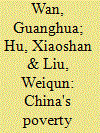| Srl | Item |
| 1 |
ID:
182775


|
|
|
|
|
| Summary/Abstract |
Miracle reductions in absolute poverty led China to announce, in late 2019, the strategic change from targeting absolute poverty to targeting relative poverty. After highlighting China's success in the fight against absolute poverty, this paper attempts to assess the roles of growth and income inequality in affecting both absolute and relative poverty rates. Poverty decomposition and panel-VAR modelling results show that growth played an overwhelming role in achieving the miracle of poverty reduction but relative poverty has been consistently rising. And growth, contrary to the case of absolute poverty, actually has contributed to the rising trend of relative poverty. Conversely, income inequality has played a small role in aggravating absolute poverty but a moderate role in raising relative poverty. Therefore, it seems appropriate for China to continue targeting absolute poverty with a higher poverty line. In the case that China insists on shifting the poverty alleviation strategy, market-led growth can no longer be relied on to reduce relative poverty. Instead, government-led pro-poor policies must be instituted by providing employment, education, training and other opportunities to the disadvantaged groups, in addition to the usual social assistance.
|
|
|
|
|
|
|
|
|
|
|
|
|
|
|
|
| 2 |
ID:
180688


|
|
|
|
|
| Summary/Abstract |
The paper aims to analyze poverty issues in rural households of India sampled purposively from the perspective of per capita Monthly Consumption Expenditure. In addition, the decomposition of poverty across social group affiliation and economic status adds another flavor to this study. The study concentrates on one of the backward areas of West Bengal, the district of Purulia, a resource-poor district with a distinct presence of scheduled social group population. The candidate villages were selected purposively keeping in mind the aspects of physical isolation and socio-economic stagnancy. Quantitative tools like Stepwise Multiple Regression and Decomposition analysis by FGT indices were instrumental in estimating the relative strengths of the factors affecting poverty. Besides, the study has simultaneously added the life history approach to integrate the QUAN-QUAL methods with an aim to produce a more complete picture. The critical findings include that the scheduled social groups, especially tribes, and daily wage casual laborers followed by agricultural laborers, were identified as the most vulnerable to poverty indicators in their respective population segments.
|
|
|
|
|
|
|
|
|
|
|
|
|
|
|
|